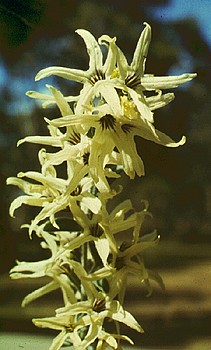 Voucher: Haegi 1379 . Photo: L. Haegi © L. Haegi |
 Line drawing by M. Perkins (from L.Haegi, unpubl. thesis). |

Synonymy
Cyphanthera albicans subsp. notabilis Haegi, Telopea 2(2): 176 (1981)
T: Timor Rock, Warrumbungle Ranges, N.S.W., L. Haegi 1379; lecto: CANB; iso: AD, K, L, MO, NSW.
Description
Erect shrub to 3 m, greyish. Branches granular-tomentose or pubescent with mainly dendritic, non-glandular hairs and scattered glandular hairs.
Leaves elliptic to ovate-elliptic or obovate-elliptic, almost sessile, 15–25 mm long, 3–6 mm wide, tomentose; juvenile leaves to 13 cm long, 4 cm wide.
Inflorescence panicle-like, dense, leafy; pedicels 1–6 mm long. Calyx 2–5.5 mm long, sparsely to densely pubescent. Corolla 13–22 mm long, glabrous outside, white, cream or pale yellow, the striations purple; lobes ovate-truncate to almost linear, 3–15 mm long. Stamens 2–5 mm long.
Capsule globose to broadly ellipsoid, 2.5–8 mm long. Seeds 2.3–3.8 mm long.
Distribution and ecology
Endemic to the Warrumbungle Ranges in North Western Slopes region of N.S.W.
Grows on rocky slopes in dark sandy soils derived from igneous rocks; common in shrub-land on exposed sites, but occurs sporadically in dry sclerophyll forest.
Common name
Grey Ray Flower
Notes
Distinction form other subspecies
Distinct from subsp. albicans by its longer leaves and corolla and distribution restricted to the Warrumbungle Ranges.
Distinct from subsp. tomentosa by its by its white or cream, rather than yellow, corolla and by the looser indumentum on the branches and leaves in which the hairs are 0.3-0.8 mm long, compared to the close tomentum of subsp. tomentosa in which the hairs are less than 0.3 mm long.
Phylogeny
Phylogenetic studies by Garcia & Olmstead (2003) on the Tribe Anthocercideae using two chloroplast DNA regions included this species The studies indicated that Cyphanthera is not monophyletic. Cyphanthers odgersii showed a closer relationship to Grammosolen while the rest of the Cyphanthera species combined to form a clade with Duboisia and Crenidium.
Reference: V.F.Garcia & R.G.Olmstead (2003). Phylogenetics of Tribe Anthocercideaea (Solanaceae) based on ndhF and trnL/F sequence data. Systematic Botany 28: 609-615.
Selected specimens
N.S.W.: Warrumbungle Ranges, L. Haegi 1588 (AD, BRI, CANB, F, NSW, PERTH); Warrumbungle Mtns, H.S. McKee 248 (MEL, NE, NSW, SYD).
Images and information on web
Further information and images of this species in NSW can be seen on the PlantNET site.
Pharmacology:
A discussion of the tropane alkaloids which occur in Cyphanthera and other Anthocercideae can be found in Griffith & Lin (2000).Ref: W.J. Griffin & G.D. Lin (2000). Chemotaxonomy and geographical distribution of tropane alkaloids. Phytochemistry 53: 627–628.